
The Temple in Jerusalem, or alternatively the Holy Temple, refers to the two religious structures that served as the central places of worship for Israelites and Jews on the modern-day Temple Mount in the Old City of Jerusalem. According to the Hebrew Bible, the First Temple was built in the 10th century BCE, during the reign of Solomon over the United Kingdom of Israel. It stood until c. 587 BCE, when it was destroyed during the Babylonian siege of Jerusalem. Almost a century later, the First Temple was replaced by the Second Temple, which was built after the Neo-Babylonian Empire was conquered by the Achaemenid Persian Empire. While the Second Temple stood for a longer period of time than the First Temple, it was likewise destroyed during the Roman siege of Jerusalem in 70 CE.

The Temple Mount, also known as Haram al-Sharif, al-Aqsa Mosque compound, or simply al-Aqsa, and sometimes as Jerusalem's holyesplanade, is a hill in the Old City of Jerusalem that has been venerated as a holy site in Judaism, Christianity, and Islam for thousands of years.

The Western Wall, known in the West as the Wailing Wall, and in Islam as the Buraq Wall, is a portion of ancient limestone wall in the Old City of Jerusalem that forms part of the larger retaining wall of the hill known to Jews and Christians as the Temple Mount. Just over half the wall's total height, including its 17 courses located below street level, dates from the end of the Second Temple period, and is believed to have been begun by Herod the Great. The very large stone blocks of the lower courses are Herodian, the courses of medium-sized stones above them were added during the Umayyad period, while the small stones of the uppermost courses are of more recent date, especially from the Ottoman period.

Mount Gerizim is one of two mountains in the immediate vicinity of the Palestinian city of Nablus and the biblical city of Shechem. It forms the southern side of the valley in which Nablus is situated, the northern side being formed by Mount Ebal. The mountain is one of the highest peaks in the West Bank and rises to 881 m (2,890 ft) above sea level, 70 m (230 ft) lower than Mount Ebal. The mountain is particularly steep on the northern side, is sparsely covered at the top with shrubbery, and lower down there is a spring with a high yield of fresh water. For the Samaritan people, most of whom live around it, Mount Gerizim is considered the holiest place on Earth.
The "Third Temple" refers to a hypothetical rebuilt Temple in Jerusalem. It would succeed Solomon's Temple and the Second Temple, the former having been destroyed during the Babylonian siege of Jerusalem in c. 587 BCE and the latter having been destroyed during the Roman siege of Jerusalem in 70 CE. The notion of and desire for the Third Temple is sacred in Judaism, particularly in Orthodox Judaism. It would be the most sacred place of worship for Jews. The Hebrew Bible holds that Jewish prophets called for its construction prior to, or in tandem with, the Messianic Age. The building of the Third Temple also plays a major role in some interpretations of Christian eschatology.
Religion in Israel is manifested primarily in Judaism, the ethnic religion of the Jewish people. The State of Israel declares itself as a "Jewish and democratic state" and is the only country in the world with a Jewish-majority population. Other faiths in the country include Islam, Christianity and the religion of the Druze people. Religion plays a central role in national and civil life, and almost all Israeli citizens are automatically registered as members of the state's 14 official religious communities, which exercise control over several matters of personal status, especially marriage. These recognized communities are Orthodox Judaism, Islam, the Druze faith, the Catholic Church, Greek Orthodox Church, Syriac Orthodox Church, Armenian Apostolic Church, Anglicanism, and the Baháʼí Faith.
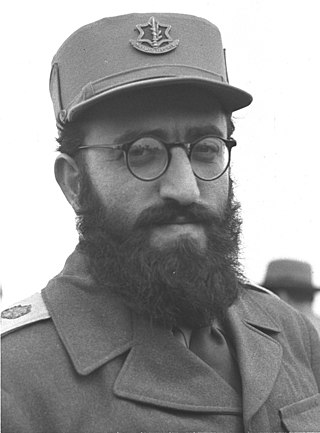
Shlomo Goren, was a Polish-born Israeli rabbi and Talmudic scholar. An Orthodox Jew and Religious Zionist, he was considered a foremost rabbinical legal authority on matters of Jewish religious law (halakha). In 1948, Goren founded and served as the first head of the Military Rabbinate of the Israel Defense Forces (IDF), a position he held until 1968. Subsequently, he served as Chief Rabbi of Tel Aviv–Jaffa between 1968 and his 1972 election as the Chief Rabbi of Israel; the third Ashkenazi Jew to hold office. After his 1983 retirement from the country's Chief Rabbinate, Goren served as the head of a yeshiva that he established in Jerusalem.

Women of the Wall is a multi-denominational Jewish feminist organization based in Israel whose goal is to secure the rights of women to pray at the Western Wall, also called the Kotel, in a fashion that includes singing, reading aloud from the Torah and wearing religious garments. Pew Research Center has identified Israel as one of the countries that place "high" restrictions on religion, and there have been limits placed on non-Orthodox streams of Judaism. One of those restrictions is that the Rabbi of the Western Wall has enforced gender segregation and limitations on religious garb worn by women. When the "Women of the Wall" hold monthly prayer services for women on Rosh Hodesh, they observe gender segregation so that Orthodox members may fully participate. But their use of religious garb, singing and reading from a Torah have upset many members of the Orthodox Jewish community, sparking protests and arrests. In May 2013 a judge ruled that a 2003 Israeli Supreme Court ruling prohibiting women from carrying a Torah or wearing prayer shawls had been misinterpreted and that Women of the Wall prayer gatherings at the wall should not be deemed illegal.

The Passover sacrifice, also known as the Paschal lamb or the Passover lamb, is the sacrifice that the Torah mandates the Israelites to ritually slaughter on the evening of Passover, and eat on the first night of the holiday with bitter herbs and matzo. According to the Torah, it was first offered on the night of the Exodus from Egypt. Although practiced by Jews in ancient times, the sacrifice is today only part of Beta Israel, Karaite and Samaritan observance.

Since the 10th century BCE, Jerusalem has been the holiest city, focus and spiritual center of the Jews. Jerusalem has long been embedded into Jewish religious consciousness and Jews have always studied and personalized the struggle by King David to capture Jerusalem and his desire to build the Holy Temple there, as described in the Book of Samuel and the Book of Psalms. Many of King David's yearnings about Jerusalem have been adapted into popular prayers and songs. Jews believe that in the future the rebuilt Temple in Jerusalem will become the center of worship and instruction for all mankind and consequently Jerusalem will become the spiritual center of the world.

Yehuda Etzion is an Israeli religious right-wing activist and the founder of Hai Vekayam, a group dedicated to allowing Jewish prayer on the Temple Mount. He was a member of the Jewish Underground and participated in a plot to blow up the Dome of the Rock, for which he was arrested and imprisoned in 1984 for acts of terrorism.

Otzma Yehudit or Jewish Power is a far-right political party in Israel, which has been referred to as Kahanist and anti-Arab. It was originally formed as Otzma LeYisrael, on 13 November 2012 by MKs Aryeh Eldad and Michael Ben-Ari, who split from the National Union to form a new party ahead of the 2013 elections.
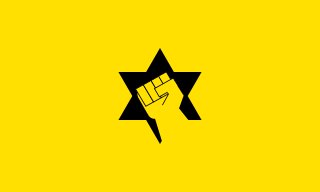
Kahanism is a religious Zionist ideology based on the views of Rabbi Meir Kahane, founder of the Jewish Defense League and the Kach party in Israel.
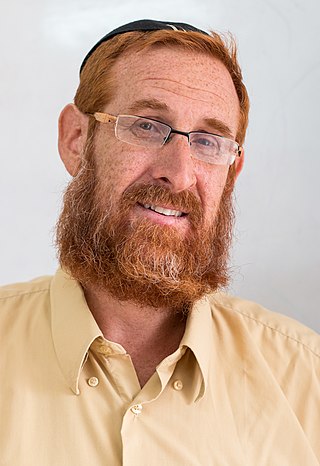
Yehudah Joshua Glick, alternatively spelled "Yehuda Glick", is an American-born Israeli Orthodox rabbi and politician, described as a "right-wing" or "far-right" activist. As the President of Shalom Jerusalem Foundation, he campaigns for expanding Jewish access to the Temple Mount. He was a member of the Knesset for Likud, having taken the place of former Defense Minister Moshe Ya'alon in May 2016 until April 2019.

At present, the Government of Israel controls access to the Temple Mount, also known as Al-Aqsa Mosque compound, in East Jerusalem's Old City, which is a holy place for Muslims, Jews, and Christians and an Islamic religious endowment under the management of the Jordan-based Jerusalem Islamic Waqf. There are entry limits to the Temple Mount for political and security reasons. In addition, Jewish religious law imposes restrictions on religious Jews on entering the compound.

Itamar Ben-Gvir is an Israeli lawyer and far-right extremist politician who has served as the Minister of National Security since 2022. He is a member of the Knesset and leader of Otzma Yehudit.
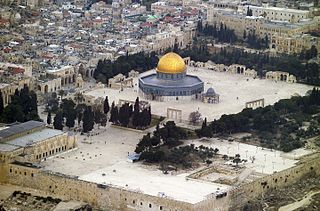
On 15 April 2022, clashes erupted between Palestinians and Israeli Security Forces on the Al-Aqsa Compound in the Old City of Jerusalem. According to the United Nations Special Coordinator for the Middle East Peace Process, the clashes began when Palestinians threw stones, firecrackers, and other heavy objects at Israeli police officers. The policemen used tear gas shells, stun grenades and police batons against the Palestinians. Some Palestinians afterwards barricaded themselves inside the Al-Aqsa Mosque and proceeded to throw stones at the officers. In response, police raided the mosque, arresting those who had barricaded themselves inside. In addition, some damage was done to the mosque's structure.
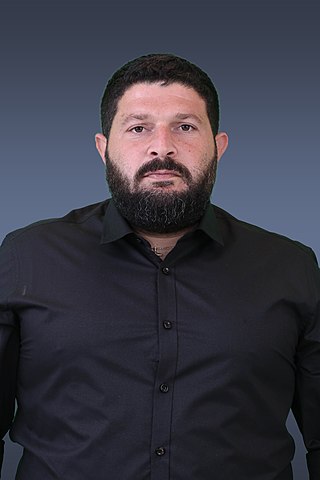
Almog Cohen is an extremist Israeli far-right politician, former police officer, and militia founder from the city of Beersheba in the Negev region. He has served as a member of the Knesset for Otzma Yehudit since 2022. He has served as a regional coordinator for the party. Owing to his police and militia background, Cohen acquired nicknames including "the sheriff" and "the warrior from the Negev" within the party.

A series of violent confrontations occurred between Palestinians and Israeli police at the Al-Aqsa Mosque compound in Jerusalem in April 2023. After the evening Ramadan prayer, Palestinians barricaded themselves inside the mosque, prompted by reports that Jews planned to sacrifice a goat at the site. In response, Israeli police raided the mosque in riot gear, injuring 50 people and arresting at least 400.
Al-Aqsa has been the site of frequent clashes between Palestinian Arab visitors and both Israeli security forces and Israeli groups, beginning with the 1990 Temple Mount killings, or Al-Aqsa Massacre, and most recently culminating in the 2023 Al-Aqsa clashes.















